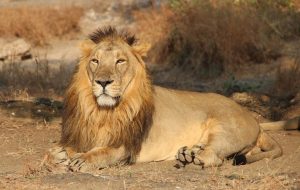 The Asiatic lion was first described in 1826 by the Austrian zoologist Johann N. Meyer who named it Felis leo persicus. the 19th century, it occurred in eastern Turkey, Iran, Mesopotamia, and from east of the Indus River to Bengal and Narmada River in Central India.Since the turn of the 20th century, it is restricted to the Gir Forest National Park and surrounding areas. This lion population has steadily increased since 2010. In May 2015, the 14th Asiatic Lion Census was conducted over an area of about 20,000 km2 (7,700 sq mi); the lion population was estimated at 523 individuals, comprising 109 adult males, 201 adult females and 213 cubs. In August 2017, a similar census revealed 650 wild individuals
The Asiatic lion was first described in 1826 by the Austrian zoologist Johann N. Meyer who named it Felis leo persicus. the 19th century, it occurred in eastern Turkey, Iran, Mesopotamia, and from east of the Indus River to Bengal and Narmada River in Central India.Since the turn of the 20th century, it is restricted to the Gir Forest National Park and surrounding areas. This lion population has steadily increased since 2010. In May 2015, the 14th Asiatic Lion Census was conducted over an area of about 20,000 km2 (7,700 sq mi); the lion population was estimated at 523 individuals, comprising 109 adult males, 201 adult females and 213 cubs. In August 2017, a similar census revealed 650 wild individuals
Behavior
- Asiatic lions, like their African cousins, are highly social animals. They live in prides of up to 5 females. Males associate with the pride only during mating and large kills.
- Females of a pride cooperate to bring down prey.
- They are active only for about 4 hours a day, spending the remainder in sleep or at rest.
- Male Asiatic lions defend their territory from marauding rival males. If defeated in the fight by way of submission or death, the younger victor takes over the pride and territory.
- Once a prey has been killed, the whole pride, including a male, who may or may not have partaken in the kill, starts devouring it. The usual pecking order is led by males, followed by older females, sub-adults, and cubs.
- They mark their territory by roaring, urine spraying, and scuff-marking.
Mating & Reproduction
Mating season for Asiatic lions continues throughout the year. The gestation period lasts for between 100 and 119 days, after which a litter of up to 6 cubs is born.
Life-cycle
Cubs are born blind and can open their eyes after 11 days. They start walking when they are 15 days old and run by 1 month of age. They are taken care of by all the females of its pride. Males that take over the pride kill cubs belonging to the defeated male to ensure that the lionesses attain estrus in a few weeks so that he can copulate and his progeny is carried forward.
Male lions become sexually mature at 5 years of age while lionesses attain gusto at 4 years.
Lifespan
Females may survive for 17-18 years while males live for around 16 years on average.
Sounds & Communication
Being a big cat, the Asiatic lion has the ability to roar. Males start to roar by the time they are of 1 year, with lionesses starting soon after. Males’ roars are louder than the female’s, and if unhindered by vegetation can be heard for miles on end.
Besides roaring, they also growl, grunt, snarl and use tactile methods for communication.
Manes of a male lion advertises his health and fertility to the others of his kind.
Diet
Asian lions eat ungulates available in their range, namely deer, antelope, buffaloes and wild boar.
Adaptations
- Retractable claws on the Asiatic lions are crooked to allow them to hold on the prey they have got their paws on while their teeth deliver the killing bite.
- The rough surface their tongues help scrape the meat off a carcass right to the bone.
- Their eyes can see many times better than human vision in the dark.
- The mane, besides adding ornamentation to male Asiatic lions, must have provided them a strong armor against the only potential competition they might have had overlapping its range, the Bengal tiger, which usually kills with a bite to the throat or the neck of its victim.











